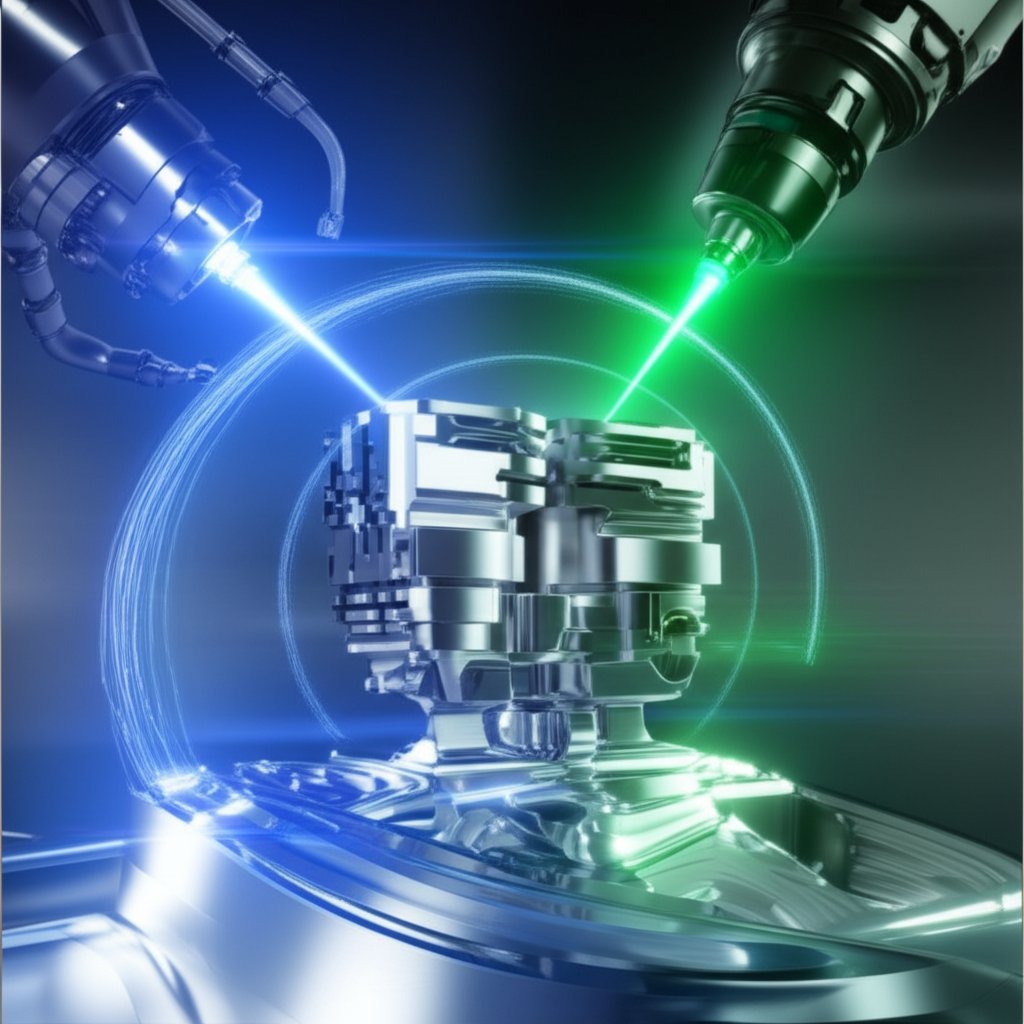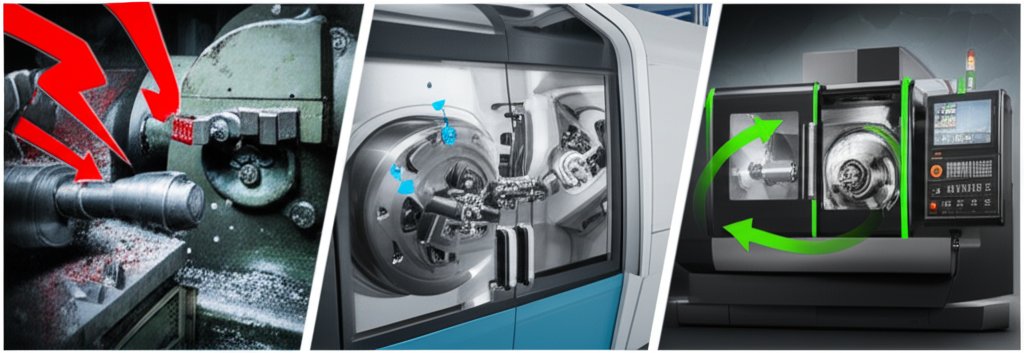What Is a CNC Turn-Mill Center? A Technical Primer

TL;DR
A CNC turn-mill center is a highly advanced, multitasking machine tool that integrates the functions of a CNC lathe (turning) and a CNC milling machine into a single, consolidated unit. This hybrid capability allows for the complete machining of complex parts with both cylindrical and prismatic features in one setup. The primary benefits include significantly improved part accuracy, greater production efficiency, and reduced manufacturing costs by eliminating the need to move a workpiece between multiple machines.
What Is a CNC Turn-Mill Center? The Core Concept Explained
A CNC (Computer Numerical Control) turn-mill center, often referred to as a multitasking or mill-turn machine, is a sophisticated piece of manufacturing equipment that combines two fundamental machining processes: turning and milling. At its core, it is a composite machine tool designed to produce intricate components that would traditionally require both a lathe and a milling machine. By merging these capabilities, a turn-mill center can execute a wide range of operations—including drilling, tapping, and boring—on a workpiece without removing it from the machine, a concept known as "Done-in-One" machining.
The fundamental mechanism that sets a turn-mill center apart is its ability to manipulate both the workpiece and the cutting tool. In a traditional turning operation (like on a lathe), the workpiece rotates at high speed while a stationary cutting tool removes material. Conversely, in a milling operation, the cutting tool rotates while the workpiece remains fixed. A turn-mill center can perform both of these actions, and in many cases, simultaneously. According to an explanation from Mastercam, the machine is configured so that both the workpiece and the tool can be rotated, allowing for the creation of complex geometries. This is often achieved through the use of multiple spindles and advanced multi-axis control, with some machines offering up to nine axes of movement for unparalleled precision.
This integrated approach is specifically designed to manufacture parts with a combination of rotational (cylindrical) and non-rotational (prismatic) features. For example, a component like an automotive camshaft is primarily cylindrical but has complex lobes and keyways that require milling. On a turn-mill center, the cylindrical shaft can be turned to size, and then the milling tools can be engaged to create the detailed features, all within the same operational sequence. This process eliminates the inaccuracies that can accumulate when a part is unclamped, moved, and re-fixtured on a separate machine. The result is higher precision, better surface finishes, and greater overall part quality.
Turn-Mill Center vs. Traditional CNC Machines: A Detailed Comparison
Understanding the value of a CNC turn-mill center requires comparing it to its more conventional counterparts: the CNC turning center (or lathe) and the CNC machining center (or mill). While all are staples of modern manufacturing, they serve different purposes based on their core functionalities. The primary distinction lies in specialization versus integration; turning and machining centers are specialists, while a turn-mill center is an integrated generalist capable of performing both roles.
A CNC turning center, an advanced version of a CNC lathe, primarily rotates the workpiece against a cutting tool. As detailed by MachineMetrics, while modern turning centers may have "live tooling" that allows for simple milling or drilling operations, their main function is to produce cylindrical parts. A CNC machining center operates on the opposite principle: it rotates a cutting tool (like an end mill or drill bit) at high speed and moves it across a stationary workpiece to create flat surfaces, pockets, holes, and complex 3D contours. For parts requiring both types of operations, the traditional workflow involves machining on one machine, then moving it to the second for subsequent operations—a process that introduces potential for error and adds significant setup time.
A turn-mill center eliminates this inefficiency by combining these functions. It features a main spindle for turning operations and a dedicated milling spindle that can work on the part from various angles. This integration is particularly beneficial for complex, high-precision components where maintaining concentricity and positional accuracy between features is critical. The following table breaks down the key differences:
| Feature | CNC Turn-Mill Center | CNC Turning Center | CNC Machining Center |
|---|---|---|---|
| Primary Function | Integrated turning and milling | Primarily turning (rotating workpiece) | Primarily milling (rotating tool) |
| Axis Capabilities | High (typically 5-axis or more) | Lower (typically 2-4 axes) | Moderate to high (3-5 axes) |
| Part Complexity | Very high (mixed geometries) | Low to moderate (mostly cylindrical) | Moderate to high (prismatic, 3D contours) |
| Setup & Handling | Single setup ("Done-in-One") | Single setup for turning operations only | Single setup for milling operations only |
| Ideal Application | Complex medical, aerospace, automotive parts | Shafts, pins, fittings, radially symmetrical parts | Blocks, plates, molds, complex housings |
While the initial investment in a turn-mill center is higher, the long-term benefits in terms of reduced labor, less floor space, and minimized scrap from handling errors often provide a strong return on investment for shops producing complex parts. The choice between these machines ultimately depends on the specific geometry of the parts being manufactured.

Key Advantages and Strategic Applications of Turn-Mill Machining
The adoption of turn-mill machining centers is driven by a powerful combination of advantages that directly address the core challenges of modern manufacturing: precision, efficiency, and cost-effectiveness. By consolidating operations, these machines deliver tangible benefits that make them indispensable in high-stakes industries. As noted by Sahil Machines, this technology streamlines the manufacturing process and ensures precise machining of complex geometries. These advantages translate into strategic applications where complexity and quality cannot be compromised.
The primary benefits of turn-mill technology include:
- Increased Accuracy and Precision: The most significant advantage is the elimination of errors associated with re-fixturing a part. Every time a workpiece is moved from a lathe to a mill, there is a risk of misalignment, which can lead to tolerance stacking and inaccuracies. By completing all operations in a single clamping, turn-mill centers maintain a consistent datum, resulting in higher dimensional accuracy and superior surface finishes.
- Enhanced Productivity and Efficiency: "Done-in-One" machining dramatically reduces total production time. It eliminates time spent on machine setup, part transfer, and inspection between operations. This leads to shorter cycle times, increased throughput, and faster delivery to the customer.
- Reduced Costs: Although the initial capital outlay is high, turn-mill centers can lower overall operational costs. They reduce the need for multiple machines, saving valuable floor space. Furthermore, they decrease labor costs associated with machine setup and part handling, and minimize the number of jigs and fixtures required.
- Greater Part Complexity: These machines open the door to manufacturing highly complex parts that would be impractical or impossible to produce using separate turning and milling stages. The ability to perform 5-axis simultaneous machining allows for the creation of intricate contours and off-axis features with ease.
These capabilities make turn-mill centers essential in several key industries:
- Aerospace: For producing components like turbine blades, engine casings, and complex structural parts that demand tight tolerances and are often made from difficult-to-machine alloys.
- Medical: In the fabrication of surgical instruments, orthopedic implants (such as bone screws and artificial joints), and dental prosthetics, where precision and material integrity are critical.
- Automotive: For machining critical powertrain and transmission components like camshafts, crankshafts, and complex valve bodies.
- Oil & Gas: For manufacturing durable and intricate components for downhole drilling tools, valves, and exploration equipment.
For businesses looking to leverage such advanced manufacturing, especially in the prototyping and development stages, partnering with a specialized service is crucial. For instance, services that offer comprehensive formative manufacturing solutions can provide essential Design for Manufacturability (DFM) feedback. Organizations like XTJ's formative manufacturing services specialize in accelerating product development for these types of complex parts, offering rapid prototypes across a wide range of materials with certified quality control.
Frequently Asked Questions
1. What is a Turn-Mill Center?
A turn-mill center is a hybrid CNC machine that combines the functionalities of a lathe (turning the workpiece) and a milling machine (rotating a cutting tool) into one machine. This allows it to produce complex parts with both cylindrical and non-cylindrical features in a single setup, improving accuracy and efficiency.
2. What is a CNC turning center?
A CNC turning center is an advanced type of CNC lathe. It is primarily used for turning operations, where the workpiece rotates while a cutting tool removes material. Many modern turning centers are equipped with additional capabilities like live tooling for simple milling, drilling, or tapping, making them more versatile than a basic lathe but less capable than a full turn-mill center.
3. What is the difference between a CNC lathe and a CNC turning center?
The terms are often used interchangeably, but a CNC turning center is generally considered more advanced than a standard CNC lathe. A turning center typically has more tooling capacity (e.g., a tool turret), may include live tooling, and often features an enclosure for safety and coolant management. A basic CNC lathe is simpler, often with fewer axes and a more limited toolset.
4. What is the difference between a turning and a milling center?
The primary difference lies in which component rotates. In a turning center, the workpiece rotates at high speed, and a stationary tool cuts it. In a milling center (or machining center), the cutting tool rotates at high speed, and it is fed into a stationary workpiece. A turn-mill center is capable of performing both actions.





